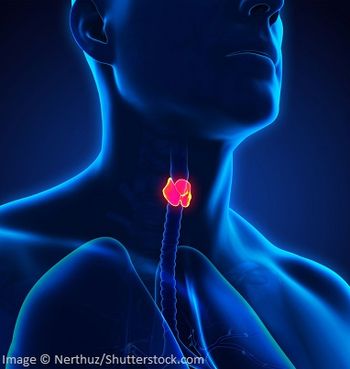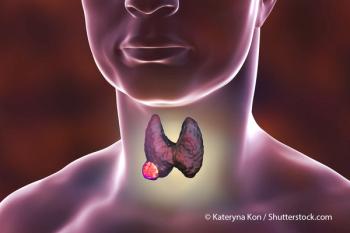
- ONCOLOGY Vol 16 No 3
- Volume 16
- Issue 3
Current Approaches to the Treatment of Well-Differentiated Thyroid Cancer
The increasing frequency of diagnosis and death of patients with follicular cell-derived carcinoma of the thyroid substantiates the need for a broad understanding of the optimal diagnostic and treatment strategies for this disease. Dr. Angelos has provided a good overview of the treatment modalities and approaches to follow-up for these patients. However, several points require additional emphasis or detail.
The increasing frequency of diagnosis and death ofpatients with follicular cell-derived carcinoma of the thyroid substantiatesthe need for a broad understanding of the optimal diagnostic and treatmentstrategies for this disease. Dr. Angelos has provided a good overview of thetreatment modalities and approaches to follow-up for these patients. However,several points require additional emphasis or detail.
Prognosis and Staging
More than 1,200 patients die annually from follicular cell-derivedcarcinoma or the complications of its treatment, with 10-year relative survivalrates of about 95% and 90% for papillary and nonoxyphilic follicular carcinoma,respectively.[1,2] Recurrence rates are usually at least twice that of mortalityrates for these patients. Major prognostic factors at diagnosis associated withincreased risk for eventual disease-related mortality include larger tumor size,invasion of the primary tumor into extrathyroidal tissues, extracervicalmetastases, and older age.
Similarly, disease recurrence or progression is associated with theseparameters, but age is a double-edged sword; ie, the youngest patientsexperience high recurrence and progression rates as well. Multiple minor factorshave also been identfied, but there exists far less agreement about theimportance of variables such as multifocality and locoregional nodalinvolvement. Certain histologic subtypes may represent more aggressive disease;eg, the tall cell variant of papillary carcinoma or the oxyphilic (Hürthlecell) variant of follicular carcinoma.
Microscopic, immunohistochemical, and molecular features that have beenassociated with a greater risk of either recurrence or death include increasedtumor vascularity, aneuploidy, increased epidermal growth factor (EGF)-receptorand decreased thyroid-stimulating hormone (TSH)-receptor status, and thepresence of the ret/PTC3 oncogene isoform.[3] The variation in the appearanceand behavior of the various subtypes of follicular cell-derived carcinomamakes the phrase "well-differentiated thyroid carcinoma" archaic andmay lead to underestimates of the potential for morbidity and mortality.
Whether to use prognostic staging and how to select among the variousapproaches to staging remain significant challenges for the practicingclinician. In addition to the three risk group classifications cited by Dr.Angelos, numerous other approaches have been proposed, including those developedby the American Joint Commission on Cancer (AJCC), European Organization forResearch and Treatment of Cancer (EORTC), Clinical Class, Ohio State University,National Thyroid Cancer Treatment Cooperative Study, Mayo Clinic (MACIS, formetastases, age, completeness of surgery, invasion of cancer, size), and LaheyClinic (AMES, for age, metastases, extent, size).[4] Two recent studiesdemonstrated the superior predictive value of the AJCC approach comparedwith the Clinical Class, Ohio State, MACIS, and AMES strategies, leading tothe widespread recognition and incorporation of the AJCC classification strategyinto two consensus treatment guidelines.[5,6]
Role of TSH-Suppression Therapy
The recurrence and cancer-specific mortality rates of follicular cell-derivedcarcinoma are significantly reduced in patients treated with TSH-suppressivedoses of thyroid hormone.[7,8] However, the optimal TSH level to be achieved inindividual patients is uncertain.
Potential morbidity from overly aggressive suppression therapy may includeosteoporosis and subsequent risk of fracture,[9] particularly amongpostmenopausal women not treated with estrogen replacement therapy. Others havereported increased risk of cardiac tachyarrhythmias (eg, atrial fibrillation)and cardiac hypertrophy. It seems reasonable, therefore, to treat patients withdoses of thyroid hormone that suppress serum TSH in accord with the patient’sinitial clinicopathologic features, ranging from the lower portion of the normalrange for T1, N0, M0 tumors to below 0.05 mU/L for T4 or M1 disease.[10] Thedegree of suppression may be reduced in patients who remain disease-free formore than 5 to 10 years, as well as in those with other mitigatingfactors such as cardiac disease.
Role of Ultrasound in Long-Term Monitoring
Recurrence of follicular cell-derived carcinoma can occur decades afterinitial therapy, mandating the need for careful multimodality monitoring.Radioiodine scanning and serial serum thyroglobulin measurements providespecific indications of disease status. However, neck recurrences, particularlythose in the central neck that are indicative of high risk for mortality, areoften associated with false-negative radioiodine scans and thyroglobulinlevels.[11] Therefore, high-resolution ultrasound coupled with fine-needleaspiration of suspicious lesions has emerged as a recommended component oflong-term follow-up, particularly for patients who initially presented witheither locoregional nodal or extrathyroidal disease.[5,12]
Conclusions
In contrast to knowledge bases for most other forms of cancer, data fromprospective, randomized clinical trials are generally lacking for follicularcell-derived carcinoma. This caveat holds true for the detection of initialdisease, primary treatments, adjuvant therapy, long-term monitoring strategies,and treatment of recurrent or progressive disease. Nonetheless, most patientswith this disease can be cured with little morbidity when managed appropriatelyby experienced physicians and surgeons.
References:
1. Gilliland FD, Hunt WC, Morris DM, et al: Prognostic factors for thyroidcarcinoma: A population-based study of 15,698 cases from the Surveillance,Epidemiology and End Results (SEER) program 1973-1991. Cancer 79:564-573, 1997.
2. Hundahl SA, Fleming ID, Fremgen AM, et al: A National Cancer Data Basereport on 53,856 cases of thyroid carcinoma treated in the US, 1985-1995. Cancer83:2638-2648, 1998.
3. Dean DS, Hay ID: Prognostic indicators in differentiated thyroidcarcinoma. Cancer Control 7:229-239, 2000.
4. Sherman SI: Clinicopathologic and prognostic staging for thyroidcarcinomas. Thyroid Today 23:1-9, 2000.
5. Sherman SI: NCCN Practice Guidelines for Thyroid Cancer, version 2000.Rockledge, Pa, National Comprehensive Cancer Network, Inc, 2000.
6. Cobin RH, Gharib H, Bergman DA, et al: AACE/AAES medical/surgicalguidelines for clinical practice: Management of thyroid carcinoma. Endocr Pract7:202-220, 2001.
7. Cooper DS, Specker B, Ho M, et al: Thyrotropin suppression and diseaseprogression in patients with differentiated thyroid cancer: Results from theNational Thyroid Cancer Treatment Cooperative Registry. Thyroid 8:737-744, 1998.
8. Pujol P, Daures J-P, Nsakala N, et al: Degree of thyrotropin suppressionas a prognostic determinant in differentiated thyroid cancer. J Clin EndocrinolMetab 81:4318-4323, 1996.
9. Bauer DC, Ettinger B, Nevitt MC, et al: The Study of OsteoporoticFractures Research Group: Risk for fracture in women with low serum levels ofthyroid-stimulating hormone. Ann Intern Med 134:561-568, 2001.
10. Sherman SI, Gillenwater AM, Goepfert H: Advances in the management ofcancer of the thyroid gland. Advances in Otolaryngology-Head and Neck Surgery14:75-106, 2000.
11. Franceschi M, Kusic Z, Franceschi D, et al: Thyroglobulin determination,neck ultrasonography and iodine-131 whole-body scintigraphy in differentiatedthyroid carcinoma. J Nucl Med 37:446-451, 1996.
12. Krishnamurthy S, Bedi DG, Caraway NP: Ultrasound-guided fine-needleaspiration biopsy of the thyroid bed. Cancer 93:199-205, 2001.
Articles in this issue
almost 24 years ago
Single-Agent Rituximab in Early-Stage Chronic Lymphocytic Leukemiaalmost 24 years ago
Recruitment for Trial of Adjuvant Trastuzumab Under Wayalmost 24 years ago
Rituximab in the Treatment of Acquired Factor VIII Inhibitorsalmost 24 years ago
Support for New Medicare Pay Formulaalmost 24 years ago
Irinotecan-Containing Regimen Improves Survival in Small-Cell Lung CancerNewsletter
Stay up to date on recent advances in the multidisciplinary approach to cancer.

















































































